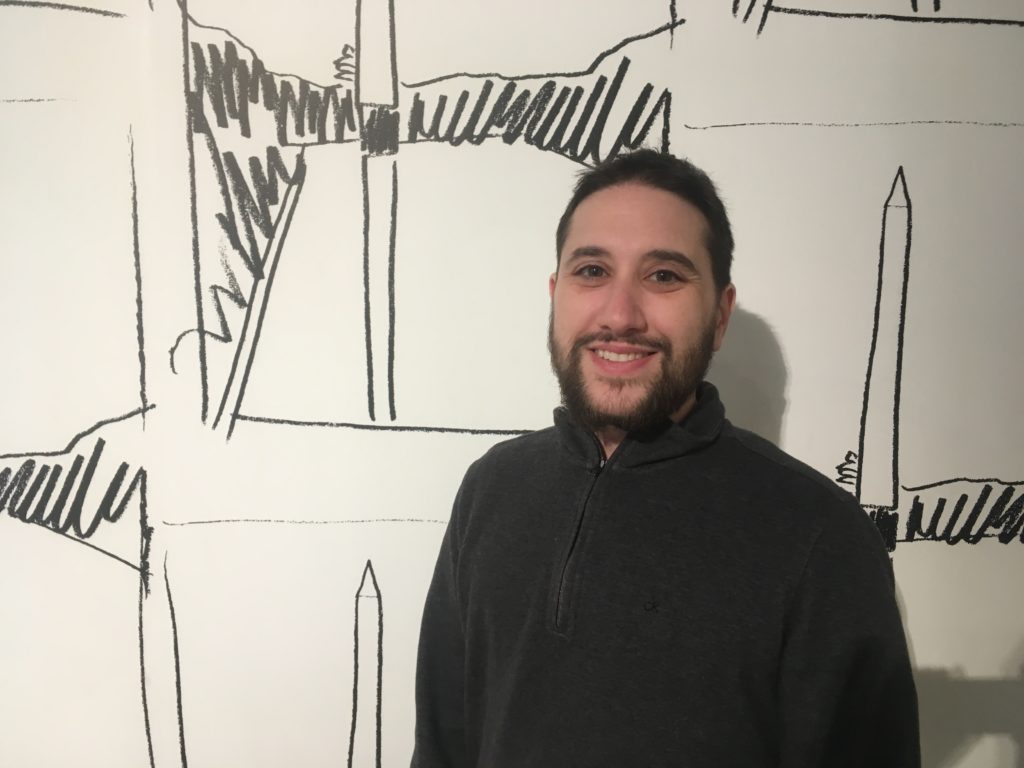New GU Gallery Features Work by Glenn Ligon
By • March 28, 2019 0 1016

In 1966, Andy Warhol screen-printed pink cow heads on yellow wallpaper for a show at the Leo Castelli Gallery in New York. Another of his wallpaper designs, purple Mao heads on a white background, was inspired by President Richard Nixon’s 1972 trip to China.
Warhol must have had the nation on his mind in 1974, when the “Mao” wallpaper appeared. That same year, he also created black-and-white wallpaper with a repeated sketch of the Washington Monument and its mirror image in the Lincoln Memorial Reflecting Pool.
With permission from the Andy Warhol Foundation for the Visual Arts, Warhol’s “Washington Monument” wallpaper has been refabricated by the Andy Warhol Museum as the background for five paintings from Glenn Ligon’s “Grey Hands” series, on view through April 7 at Georgetown University’s new Maria & Alberto de la Cruz Art Gallery in the exhibition “Glenn Ligon: To be a Negro in this country is really never to be looked at.”
On Monday, April 1, at 6:30 p.m., the gallery, located at 3535 Prospect St. NW, will host a free public conversation between Ligon and Steven Nelson, art history professor and director of the African Studies Center at UCLA. Nelson is currently Andrew W. Mellon Professor at the National Gallery of Art’s Center for Advanced Study in the Visual Arts.
The five “Grey Hands” paintings are press images from the Million Man March of 1995, silkscreened on canvas (à la Warhol). Made the year after the march, this is the first time they have been on public view. Ligon “rolled them up and put them in storage,” says Al Miner, founding director and chief curator of the de la Cruz Gallery.
According to Miner, Ligon decided to exhibit the works now due to “the political moment.” It occurred to the artist to show them against the Warhol wallpaper “because the March itself was in juxtaposition to the symbols of American democracy such as the Washington Monument and the Capitol building,” explains text written by Ligon, who was born in the Bronx in 1960.
Noting that the Million Man March was preceded by a silent march against lynching in 1922 and 1963’s March on Washington, Ligon writes: “I am interested in this recurring, continual need for African Americans to assert our visibility in a country in which we have been crucial presences from the beginning.”
The “To be a Negro …” title of the exhibition is a quote from James Baldwin, who Miner calls the artist’s “creative muse.” Much of Ligon’s work makes use of the printed word. The show also includes archival pigment prints inspired by Baldwin’s “Stranger in the Village” essay and six works from Ligon’s 2008-9 series “Study for Negro Sunshine” — based on a passage from Gertrude Stein’s novella “Three Lives” — along with drawings and a recent red version of “Study for Negro Sunshine.”
Showing Ligon’s work is a coup for a university museum. His name was at the top of the list for the gallery, which aims to exhibit contemporary art that relates to issues of social justice. Fortunately, Ligon “had Georgetown connections all over the place,” says Miner, notably through his New York gallery, Luhring Augustine.
A non-collecting venue, the Maria & Alberto de la Cruz Gallery — named for its lead donors, both Georgetown alumni, and designed by D.C.-based Howard+Revis Design — opened last fall in what was the original home of the university’s Walsh School of Foreign Service. The building later housed both visual arts and performing arts programs, with a black-box theater. At one time, space was rented for shows by punk rock bands such as the Cramps.
Georgetown’s Lucille M. and Richard F.X. Spagnuolo Art Gallery, the primary exhibition space for the Department of Art and Art History, was established in 2003, and the Department of Performing Arts moved to the new Davis Performing Arts Center two years later.
Miner, who grew up in Severna Park, Maryland, began at GU in August of 2017. With an undergraduate degree from Randolph-Macon College, an M.F.A. from Queens College in New York and a certificate in museum studies from George Washington University, he has worked at the Hirshhorn Museum and was most recently a contemporary art curator at Boston’s Museum of Fine Arts.
He calls the de la Cruz Gallery “a neighborhood asset, an art community asset, a campus asset.” Referring to its corner glass tower — equipped with programmable colored lights — Miner notes with pride: “You can actually see this from Rosslyn.”

De la Cruz Gallery Director Al Miner in front of Andy Warhol’s “Washington Monument” wallpaper. Photo by Richard Selden.

